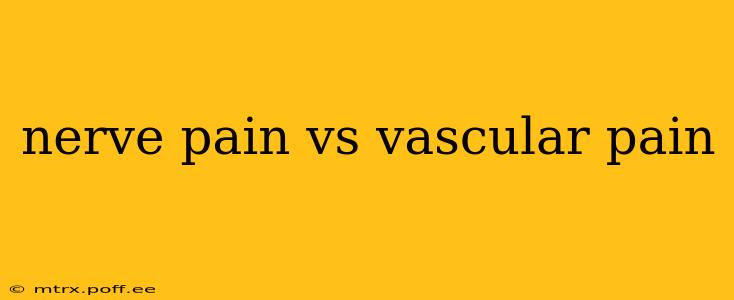Differentiating between nerve pain (neuropathic pain) and vascular pain can be crucial for accurate diagnosis and effective treatment. While both can cause significant discomfort, their underlying causes, symptoms, and treatment approaches differ considerably. This article will delve into the key distinctions between these two types of pain, answering common questions along the way.
What is Nerve Pain (Neuropathic Pain)?
Nerve pain, also known as neuropathic pain, arises from damage to or dysfunction of the nervous system. This damage can be caused by various factors, including:
- Diabetes: High blood sugar levels can damage nerves, leading to diabetic neuropathy.
- Shingles: The varicella-zoster virus, responsible for chickenpox, can reactivate and cause shingles, resulting in nerve pain.
- Multiple sclerosis (MS): This autoimmune disease attacks the protective covering of nerves, causing inflammation and pain.
- Injury: Trauma to nerves, such as from surgery or an accident, can cause persistent pain.
- Certain medications: Some medications can have nerve damage as a side effect.
- Alcohol abuse: Excessive alcohol consumption can damage nerves.
- Vitamin deficiencies: Deficiencies of certain vitamins like B12 can impact nerve function.
Symptoms of nerve pain often include:
- Burning: A sensation of intense heat or burning in the affected area.
- Tingling: A pins-and-needles feeling, often accompanied by numbness.
- Sharp, shooting pain: Brief, intense jolts of pain radiating along the affected nerve.
- Numbness: A loss of sensation in the affected area.
- Hypersensitivity: Increased sensitivity to touch, temperature, or pressure.
What is Vascular Pain?
Vascular pain originates from problems within the blood vessels. This pain is often caused by:
- Reduced blood flow: Conditions like peripheral artery disease (PAD) restrict blood flow to the extremities, causing pain, especially during exercise.
- Inflammation: Conditions like vasculitis (inflammation of blood vessels) can trigger pain.
- Blood clots: Blood clots obstructing blood flow can cause severe pain.
- Aneurysms: A weakened or ballooned blood vessel can cause pain if it presses on surrounding nerves or organs.
Symptoms of vascular pain can include:
- Cramping: Pain often described as cramping or tightness, particularly in the legs during exercise (intermittent claudication).
- Aching: A dull, persistent ache in the affected area.
- Coldness: The affected area may feel cold to the touch due to reduced blood flow.
- Skin changes: The skin may appear pale, blueish, or shiny.
- Ulcers: In severe cases, reduced blood flow can lead to skin ulcers.
How to Tell the Difference Between Nerve and Vascular Pain?
Differentiating between nerve and vascular pain can be challenging and often requires a medical professional's expertise. However, some clues can help:
- Location and pattern of pain: Nerve pain often follows a specific nerve pathway, while vascular pain may be localized to a specific area or limb.
- Type of pain: The characteristic burning, tingling, or shooting pain suggests nerve involvement, whereas cramping or aching points towards vascular problems.
- Response to exercise: Vascular pain is often exacerbated by exercise, while nerve pain may or may not be affected by physical activity.
- Associated symptoms: Nerve pain might be accompanied by numbness or hypersensitivity, while vascular pain could be associated with coldness, skin changes, or ulcers.
What are the Treatment Options for Nerve Pain?
Treatment for nerve pain depends on the underlying cause and severity of symptoms. Options can include:
- Medications: Pain relievers, antidepressants, anticonvulsants, and topical creams.
- Physical therapy: Exercises and stretches to improve mobility and reduce pain.
- Alternative therapies: Acupuncture, massage, and yoga may help manage pain.
What are the Treatment Options for Vascular Pain?
Treatment for vascular pain aims to improve blood flow and address the underlying cause. Options include:
- Lifestyle changes: Diet, exercise, and smoking cessation.
- Medications: Blood thinners, vasodilators, and cholesterol-lowering drugs.
- Surgical interventions: Angioplasty, bypass surgery, or endarterectomy in severe cases.
Can Nerve Pain and Vascular Pain Occur Together?
Yes, it's possible to experience both nerve and vascular pain simultaneously, particularly in conditions like diabetes. For example, diabetic neuropathy can affect nerves in the legs, while PAD can simultaneously reduce blood flow, leading to a combination of neuropathic and vascular pain.
What are the potential complications of untreated nerve and vascular pain?
Untreated nerve pain can lead to significant disability, depression, and anxiety. Untreated vascular pain, especially if caused by PAD, can result in limb ischemia, amputation, and even cardiovascular events.
This information is for general knowledge and does not constitute medical advice. Always consult a healthcare professional for diagnosis and treatment of any type of pain. They can accurately assess your symptoms, conduct necessary tests, and develop a personalized treatment plan to alleviate your discomfort and improve your overall health.
